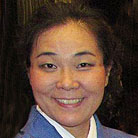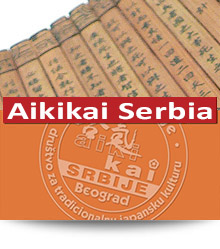An Untrained Japanese Joined AK Zemun
Dobar dan! Ja sam Kanoko i is Japan. Ja sam dođila u Beogradu sa moj mužu u Decembar 2001. Ja sam ućila Srpski ali to je verlo zametan. Moja ćerka je rođen u Zvezdara bolnica. Sada ona ima josi jedan godina i Ja mogu da dođem u Aikidu. Ja sam počela aikido u Septembar 28, 2003 i ja se zadovoljim to mnogo.
 Huuu. It was all I can handle in Serbian. Previously, my knowledge of aikido was very limited. So, I was quite a confused how to step with the movements at the first training day. Only what I understand was those technical words such as “kotegaeshi”, “iremi”, or “tenkan”, nonetheless I had no clue about what Saša-sensei was talking about. But, with Saša-sensei’s and other senior trainees’ step-by-step instructions, I gradually became comfortable with some movements.
Huuu. It was all I can handle in Serbian. Previously, my knowledge of aikido was very limited. So, I was quite a confused how to step with the movements at the first training day. Only what I understand was those technical words such as “kotegaeshi”, “iremi”, or “tenkan”, nonetheless I had no clue about what Saša-sensei was talking about. But, with Saša-sensei’s and other senior trainees’ step-by-step instructions, I gradually became comfortable with some movements.
Because I was born and grew up in Japan, I have some general ideas of what aikido or any other Budo is like in Japan. I only saw the aikido ‘embukai’ in the college, so that my comments on the aikido trainings in Zemun are very limited and may not be generalized. But, I would like to share some my observations. First, my first impression to aikido trainees was very friendly and inclusive. Saša-sensei and the trainees were very helpful to demonstrate me how to move and positions. Second, I felt their passion to aikido. I was amazed that senior trainees, despite of their young age, have been practicing more than 10 years. I believe that their passion let them continue practicing aikido. Even those who have trained aikido less than 10 years perform steadily and confidently. Many are younger than I am, but to me they look the same age of mine or older than I am. This is because, I think, aikido training let trainees’ ki (or chi) grounded. Third, I noticed some jargons are different. People here use ‘tatami’ for plastic mattress and ‘kimono’ for the white uniform. For Japanese, ‘tatami’ is rush (a kind of weed) woven mattress and ‘kimono’ is a Japanese traditional costume. The white uniform for aikido is "Do-gi". "Do" means a body and ‘gi’ is a sonant sound of ‘ki’ that is a noun form of ‘kiru’ that means ‘to wear’. But, this is how aikido-ka here uses the terms, so I have no problem with it. Lastly, I do not feel any competitive fighting energy in the ‘Do-jo’ and I feel good or even better after trainings. I was surprised to hear that other aikido trainees expressed the same good feeling.
I have been wondering why aikido makes trainees feel good. It is because aikido helps balancing mind and body. Well, there are other sports or exercises promoting balancing skills. So, then why can aikido make trainees feel good? Yes, I understand it comes from the origin of aikido. Aikido was formed from Samurai fighting movements. Samurai practiced the one-to-one movements as their daily fitness. The aikido founder, Mr. Morihei Ueshiba, designed the Samurai fighting movements to energy movements. Aikido techniques avoid direct fighting confrontations. I think he was a true Samurai. When Mr. Morihei Ueshiba was born, 1883, it was, in Japan, still the social revolution era after the Meiji Restoration started in 1867. The long Samurai (or Bushi) period that arose initially in 10th century was ending. It was a transition time. The Japanese government was implementing changing its governmental and societal system through Modernization and was learning from ‘Western countries’ in other words ‘European countries and America’. There was mixture of confusion and resistance as well as fantasizing Western culture among Japanese people. Some denied Japanese culture completely, or others, especially former Samurai, were conservative. But, the bigger energy of Japan at that time was driven by the Modernization that left a few mercy to Samurai. Finding a way to survive for Samurai was not easy in terms of daily food and their spirit. [1] ‘Bushido’, the way of ‘Bushi’ that is the other term for Samurai, was martial spirit and honor. These values were some profound ideas of Confucianism. Winning means not simply to win by physical power, but rather, in Bushido, one is encouraged to pursue spiritual trainings for conquering oneself. Only through conquering oneself is it possible to counter others. [2] Yes, I understand it is natural to fight with physical power to defeat attackers. But, Mr. Morihei Ueshiba was able to change his revenge feeling, the negative energy, which was from watching his father had been beaten up due to political reasons, into spiritual trainings in his physical training[3]. This was derived from his ability of self-awareness.
One of the aspects of the aikido training is self-awareness. I have been thinking how we get sense of the self-awareness from aikido and how we relate it to our daily life. Here is my little experience. During the training, we practice each movement of “Waza” (aikido techniques or stance), for example, “the right hand aihanmi shiho-nage would go like one step to the right, grabbing the partner’s wrist, another step to the forward, bringing his arm over my head, twisting toward the back, and throw him away. (I hope that I am correct on this description of the right hand aihanmi shiho-nage.) I just do it, or pay attention to how I do it. Paying attention is, for example, “am I anticipated on the first step?” Yes, I am. Do I know why I feel anticipated on the first step? No, I do not know, but I know that I feel the same way not only aikido, but also other situations in my daily life. My self-awareness of the aikido trainings has just begun. I know that I will discover more about myself. This is not an easy path because I confront my negative side. But, I believe that the aikido trainings will help me to balance my energy as Mr. Ueshiba has overcome it.
[1] “Japan’s History Study”, Yamakawa Publications, 2003, pp. 323-336
[2] “Nippon: the Land and its People”, Nippon Steel Corporation, 1984, pp. 328-329
[3] “aikido Yoji Fujimoto 7 dan” CD-ROM
